Porcelain Insulator News
by Jack H. Tod
Reprinted from "INSULATORS - Crown Jewels of the Wire", February 1973, page 12
I've had a couple of fellows ask who makes the artist drawings of poleline
hardware that appear each month on the "Porcelain Corner" lead page.
These were made by our good friend, Robert Winkler, Michigan City, Indiana who
is given credit each month in the index. Since we now realize that most
collectors ignore the index and get right to the meat of the magazine, we've
asked Robert to sign his drawings more prominently in the future.
We all appreciate these drawings very much. They speak for themselves; Robert
is not only a good artist, but he is a keen observer of poleline construction
practices and records all the detail faithfully in his art. Some people collect
insulators just as hunks of glass or porcelain, but the majority of us do have a
fascination for how all that stuff is used up there on the poles, be it an
insulator or a metal bracket bracing the crossarm.

The insulator at right is not a porcelain one per se, but I'm sure curious
about it. As first reported by Sue Ducro in Crown Jewels, Jan 1971, page 10,
this insulator is made from a combination of Teflon and alumina. Its specific
gravity is 1.45 times that of porcelain.
McGraw-Edison had tested these, and
their most prominent comment was that the price of about $7 each would be enough to sink it! The only information I have on it is a connection
with "Plastic Age". If anyone can furnish information as to
manufacturer or other background on this item, I would greatly appreciate it.
J. Tod

I found the 2-groove spool shown here at a mine in Arizona. It is
1-15/16" diameter by 2-1/2" tall.
The "G" marking is identical to the customary "G" so
common on all items of standard porcelain plus several pin types. What makes
this an interesting item is that it's the first instance where the "G"
has been related to anything at all. Now all we have to do is try to associate
the "HALL" with some patent or manufacturer.
Jack
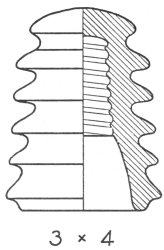
The drawing at right is of an unusual pin type porcelain in the collection of
Harold Anglin (Fontana, Cal.), and these are showing up on the west coast I
hear. This item just "smells like" a Lapp insulator on all counts, but
the files at Lapp drew a blank on it - which is par for the course. It has
threads made by the wobbler method, the usual Lapp "pumpkin" glaze and
fits the style of the early fog types made by Lapp in the 1928-1931 period.
If
anyone turns up one of these with a Lapp or other marking, give us the word.
Incidentally, this is a very cute little insulator and does a lot to
spruce up the shelf.
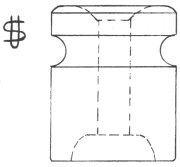
Dear Dora: (Ans. by Jack)
I'm sending a sketch of a knob I found last
weekend. The glaze is kinda crude and rough looking and appears to be quite old.
The embossing on top is the first I've seen or heard of; it's either a dollar
sign or maybe a "U" and "S".
Maybe somebody out in Insulator
Land can shed some light on the back- ground of this one. Can't tell you how
much I enjoy "Crown Jewels". Keep up the good work.
Harvey L. May,
Lincoln, Mo.
- - - - - - - - -
Dear Harvey:
This is a "standard porcelain" #4 1/2 knob, and this is a common
size. The marking is Monogram-US, one of the markings used by U.S. Electric
Porcelain Co. (1903-1911), Findlay, Ohio. This company was formerly the Bell
Pottery Co. who made dishware until the 1903 date.
The company became Findlay Electric Porcelain Co. in 1911 and operated as
such until becoming part of the Porcelain Products, Inc. merger in 1927. Shortly
there after the plant was closed and the operation combined with the other P.P.,
Inc. plant in Carey, Ohio.
Your knob was probably made during the 1903-11 period, but could have been
made later if Findlay continued to use serviceable U.S. dry press dies without
bothering to alter the marking by brazing over and repunching.
J. Tod
Dear Jack:
I have found an insulator in which I can not find any information. With this
letter I have sent a drawing of this insulator. It is brown porcelain and I have
been told that this insulator is for guy wires to protect them from secondary
lines.
I would like to know if this is what the insulator was used for. Also what
company manufactured the insulator and how rare it is. If possible could you
suggest a price?
Every collector I have shown this insulator to has never seen one like it. I
do hope you can shed some light on this insulator which has puzzled me for a
long time.
Wallace Gaughf
Jackson, Miss.

Dear Wallace:
Nope. You have a tree insulator as shown at right and below, but I grant it
could be used for other insulating purposes as well.
These data are from Pinco catalogs, but other companies may have made them
also.
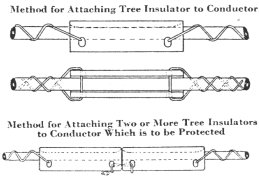
I have no way of knowing how common or scarce these are, and trade value
depends on how bad the other guy wants one. I'd make a wild guess at a TV of $5
to $10 at present. They may be common in some areas, unknown in others.
Jack
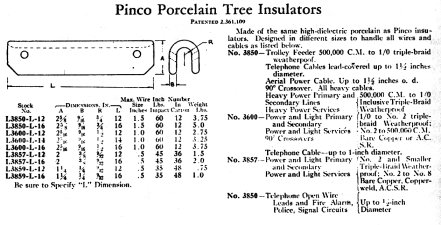
Paul Mohrs (Terre Haute, Ind.) & Harold Anglin (Fontana, Cal.) have
closed-end guy strains recess-embossed as shown at right. We can guess at attributing this marking but
can't be positive.

There were two porcelain plants in Carey (one still in operation), and I
found knobs and the like embossed "CAREY / OHIO" at the site of the
old Federal Porcelain Co. plant (1917-1927) there. However, these guy strains
more closely fit the operating history of the other plant there, National Elec.
Porc. Co. (1914-27). In any event, it's probably one or t'other of these two.
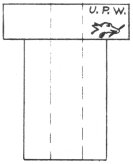
Dear Jack:
I've just come across this white porcelain tube (1-1/2" by 1-7/8"
tall) & cannot identify the maker's mark or initials (both underglaze, green
ink). Beneath the initials is what appears to be the head of a dog with a stick
in its jaws. Any help much appreciated.
Judson Fisher
Buffalo, N.Y.
- - - - - - - - -
Dear Judson:
Sorry but I don't know this one. Seems as though I've seen the dog trademark
on something else but can't recall what. We could dream up all sorts of
companies for the initials, such as Union Porcelain Works, but that wouldn't get
us very far. The porcelain companies mark specialty items with the customer's
marking, and I think this might be a fairly modern battery bushing of some sort.
Jack
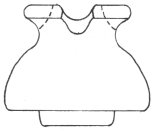
William Loeffler (Troy , N.Y.) sent this sketch (redrawn) of an unusual pin
type he has and would like information on it.
This insulator is just like the ordinary cable shape but has a 3/4"
cutout (rounded notch) in each crown ear as shown by the dotted lines in the
sketch. It is a dark brown, 3-1/2" diam by 2-7/8" tall.
Sorry, Bill, but I have no information on this thing, but we could in time
find out what it was, who made it and how it was used. I have a hunch it was
specially made for some form of clamp top arrangement such as the U-401. This is
undoubtedly a patented item and maybe sometime we will have a rainy year and I
can get back to patent search.
Dear Jack:
Enclosed in an unusual insulator that might be of interest. Our company
installed a number of these several years ago. These were manufactured by P.L.M.
Products, Inc., Cleveland, Ohio.
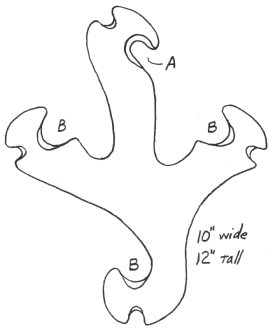
They are aerial spacer cable insulators and allow a 3-phase line to be run
with a minimum amount of space. The insulator is hung on the steel messenger
cable by hook "A" and the conductors are placed in the "B"
grooves. The smaller grooves are for tie wires.
These items are made of a high alumina ceramic which has a tensile strength
four times that of electrical porcelain.
I would appreciate what estimate of trade or sale value you would place on
this item for the collector.
Don Fabbi
Las Vegas, Nev.
- - - - - - - - -
Dear Don:
Many thanks for the info on these, and especially so because of an inquiry on
them received just the previous week. I don't have the vaguest idea of what
trade value you could get on these. Most porcelain collectors do accumulate a
few oddball line insulators as go-withs but the lack of a pin hole is at least
two strikes against it, and ones that don't sit on the shelves nicely usually
get a third strike. At least your item can be hung on a small nail on some
vacant wall space, and I'll have to admit it is an unusual conversation piece.
Jack

Scott Blake (Granada Hills, Cal) has sent a porcelain pin type with the
marking as shown at the right. This is an underglaze marking (blue ink) on the
skirt of the insulator.
The insulator itself is a sky glaze, radio treated cable similar to U-735.
Thus far I haven't been able to attribute either the insulator or the marking,
but we're working on it.
Here is final information on the interesting U-401 pin type (see November
'72, page 16). I finally came across this in a 1915 catalog in my files, and it
was listed as a "Fay Clamp Insulator". A check of the patent files
here showed this to be patent No. 894,616 of July 28, 1908 by John L. Fay, St.
Louis, Mo. These insulators were made by Ohio Brass Co. (drawing dated
10-12-10).
FOG TYPE INSULATORS
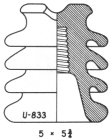
Robert Winkler (Michigan City, Ind.) and I have had a running debate for some
time about collector availability of all the Fog Type insulators, specifically
U-821 through U-844. Robert maintains they must not be generally available as
he's never seen them in use and hasn't been successful in finding a collector
who will sell or trade them.
Yet I maintain that he just doesn't get around and
that these are in general use in all coastal areas. For instance, in the Los
Angeles area the majority of the insulators are fog types -- oodles of them.
Would help if coastal collectors would bring these to shows and put them on
trade lists for us inlanders. If you have any fog types to trade, write to
Robert or us. We can print a list here of those who have 'em.
WHAT'S COOKIN' FOR THE FUTURE ?
The next "Porcelain Column" will contain the complete
"standard porcelain" chart showing all the standard solid knobs (and
spools) in the code. I've prepared all these drawings especially for this next
issue, and I'm sure they will help many collectors list their items. Since
publication of this chart will take 8 pages, question-answer items will be
deferred to the subsequent issue.
Future issues will have similar treatments for such items as B & D
cleats, one-wire cleats, wiring cleats, guy strains, telephone spools,
self-tying knobs, nail knobs, rack spools, forestry insulators, etc. -- all as
space permits.
Most porcelain collectors add these items to their collection, but I don't
know of anyone who really chases them in a big way. It's a fun type of
collecting. You can pick them up at flea markets, second-hand stores, junk yards
and electrical shops for practically nothing. We all trade them back and forth
essentially on the basis of "this here pile of mine for that there pile of
yours". The best part of this is that you can have a fairly large
collection and still get it into the house!
| 